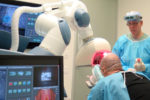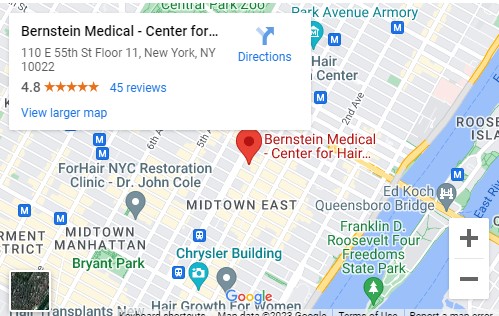A recently published study is the first to measure the perceived benefit of hair transplantation on a patient’s age, attractiveness, successfulness, and approachability – key factors that play an important role in workplace and social success. The pilot study, published in the Journal of the American Medical Association Facial Plastic Surgery, found that hair transplant recipients were perceived by others to be 3.6 years younger following their hair restoration surgery. The data indicate that the person’s attractiveness, successfulness, and approachability also showed statistically significant positive changes as a result of hair restoration surgery.
Q: Does minoxidil play any role in the survival of the grafts after a Neograft/FUE procedure? — J.W., Philadelphia, PA
A: When a doctor performs a hair transplant, the hair should be taken from the permanent zone so, by definition, that hair is not affected by medication (i.e. does not need to be maintained by either minoxidil or finasteride). If the doctors using Neograft are suggesting that minoxidil increases survival, then they are probably harvesting hair outside the permanent zone. To clarify, I use the ARTAS robotic system for our FUE procedures, not Neograft, as the former is a far more accurate device for harvesting.


Dr. Bernstein and Spencer Kobren, of The Bald Truth, talk about another seldom-discussed advantage of the ARTAS Robotic Hair Transplant System, namely how the robot brings transparency to FUE hair transplant procedures. The robot accumulates data on each action taken for the operating physician and also sends the information to Restoration Robotics for analysis. While the data helps Restoration Robotics improve each successive iteration of the robot, it also adds an extra layer of validity to clinics’ claims about procedures performed at their facility. This is in contrast to manual FUE where there is no third party monitoring or validation.
Q: Does a man’s height and weight affect the dose of finasteride or Propecia he should take? i.e. will a 6’4″ man need a higher dose than a 5’7″ man. ~ T.B. — Rye Brook, NY
A: The dose of finasteride is the same (i.e. 1mg) regardless of a person’s height or weight. The reason is that one needs only 0.5mg a day for it to be effective, so there is much leeway built into the dose (but the rate of non-responders is slightly higher at the 0.5mg/day dose). That said, after 5 years or so, finasteride seems to be less effective and doctors often increase the dose a bit. The next step-up is generally to take 1/3 of a 5mg pill each day. Keep in mind that the dosing we are speaking about is for hair loss (androgenetic alopecia). When finasteride is used for prostate enlargement, the dose is 5mg a day.
Dr. Bernstein appears on The Bald Truth where he discusses the advantages of creating recipient sites prior to follicular unit harvesting in an FUE hair transplant procedure. By allowing recipient sites to begin healing, “pre-making” the sites helps avoid graft popping and potentially reduces mechanical injury during graft insertion.
Synopsis: The current robotic system harvests follicular unit grafts in a random manner. A new capability of the ARTAS robot is to select follicular units based on the number of hairs they contain, in order to increase the hair/wound yield. This bilateral controlled study of 24 patients was designed to evaluate this functionality. Results showed that, compared to random follicular unit harvesting, robotic follicular unit graft selection produced more hairs per harvest attempt (2.60 vs. 2.22) and more hairs per graft (2.72 vs. 2.44). The clinical benefit was statistically significant at p<.01.
Q: I have a diagonal scar in the middle of my donor area that I got during a childhood accident and I am concerned that it will limit my options for hair restoration. Will this type of scar prevent me from having either FUT or FUE? Do you recommend one or the other? — R.F., Upper West Side, NY
A: Traumatic scars in the donor area do not preclude us from performing a hair transplant. With an FUT/strip procedure, we can remove all or part of the scar when we excise the donor strip. In Robotic FUE, the ARTAS Robot can be programmed to avoid a scar during harvesting. In either procedure, we can improve the appearance of the scar by implanting follicular unit grafts directly into the scar tissue. The hairs will grow permanently in the scar, just like ones we implant in the recipient area, and the scar will become harder to detect.
It is important to note that transplanted hair will not grow in a thickened scar. If your scar is thickened, the doctor can thin it out (soften it) with injections of cortisone. They are usually repeated at 4-6 week intervals in advance of the procedure. The number of injection sessions required depends upon the thickness of the scar and your individual response to the medication.
The presence of a traumatic scar should generally not determine which type of transplant you have. That should be decided in consultation with your physician based on factors such as how much volume you need, how you intend to style your hair, how short you would like to keep it, how soon you need to return to strenuous physical activity, and other general considerations for a hair transplant.
We recently posted photos from a patient who had a robotic hair transplant with a scar in his donor area. The photos include images of his donor area (with scar) before his procedure, immediately after robotic graft harvesting and 11 days post-op. View this patient’s before after photos.
- View Patient RSI’s hair transplant photos
- Read about techniques used to fix scars
- Video: How Does the ARTAS Robotic Hair Transplant System Locate and Dissect Follicular Units?
Video: How Does the ARTAS Robotic Hair Transplant System Locate and Dissect Follicular Units?






